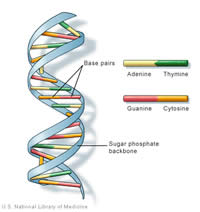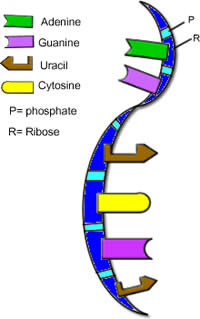Difference between DNA and RNA
Key Difference: DNA is a double-stranded molecule that encodes the genetic information used for development and functioning. RNA is a single-stranded molecule that plays vital roles in coding, decoding, regulation, and expression of genes.
 DNA, RNA and proteins are three main components play an important role in living organisms. DNA has been a widely known concept about how it stores our genetic data and decides how the human will look and sometimes cultural behavior. However, DNA is not the only component responsible for it. RNA and proteins also play an important role determining the job of a cell and what will its part in the overall structure. DNA and RNA may seem similar as they both refer to molecules made up of nucleotides, but they differ in multiple ways including make up and function.
DNA, RNA and proteins are three main components play an important role in living organisms. DNA has been a widely known concept about how it stores our genetic data and decides how the human will look and sometimes cultural behavior. However, DNA is not the only component responsible for it. RNA and proteins also play an important role determining the job of a cell and what will its part in the overall structure. DNA and RNA may seem similar as they both refer to molecules made up of nucleotides, but they differ in multiple ways including make up and function.
The DNA and RNA works together with other components to create a proper functioning human. The DNA is responsible for how the human will look and as a byproduct how it will act as well to certain extent; this is known as the extended phenotype. The DNA is responsible for storing the genetic information of how and each cell is made and what job it will perform. The data is saved in the nucleus of each cell, so all the cells have identical DNA in their nucleus. When a cell splits to create a new cell, it transfers DNA by dividing it and the second half is recreated. In order for DNA to create new proteins or pass on the function of a cell, it uses RNA to pass the message, which aids in creation of new proteins.
DNA, short for Deoxyribonucleic acid, is a molecule that encodes the genetic instructions that is used for the development and functioning of cells in a living organism and many viruses. In addition to protein and RNA, DNA is an essential macromolecule for the existence of all living organisms. The genetic information is coded as a sequence of nucleotides such as guanine, adenine, thymine, and cytosine. The main purpose of a DNA is to tell each cell what proteins it has to make. The type of protein a cell makes determines the cell’s function. DNA is inherited from parent to offspring, which is why parents and children share similar traits. Each person’s cell has about 46 double stranded DNA that is a result of the one set of chromosome that a person acquires from each parent.
The DNA molecule has a double helix shape, which resembles a ladder that is twisted into a spiral shape. Each rung of the ladder has a pair of nucleotides that stores the information. The backbone of the DNA is made up of alternating sugars (deoxyribose) and phosphate groups, from which the DNA gets its name. The nucleotides are attached to the sugar in a special formation. The adenine (A), thymine (T), cytosine (C) and guanine (G) nucleotides always form A-T and C-G pairs, though they could be found in any order on the DNA. The Adenine and thymine pair up to make two hydrogen bonds, while cytosine and guanine make three hydrogen bonds. The different order is how the DNA can write ‘codes’ out of the ‘letters’ telling the cells what duties to perform.
 The encoded information is read using the genetic code, which specifies the sequence of the amino acids in within proteins. The code is read by a transcription process, in which the DNA is copied into related nucleic acid RNA. Within the cells, DNA is placed in chromosomes that are divided during cell division. Each cell has its own complete set of chromosome. Eukaryotes store most of their DNA inside the cell nucleus and some other DNA in organelles. Prokaryotes store their DNA in the cytoplasm.
The encoded information is read using the genetic code, which specifies the sequence of the amino acids in within proteins. The code is read by a transcription process, in which the DNA is copied into related nucleic acid RNA. Within the cells, DNA is placed in chromosomes that are divided during cell division. Each cell has its own complete set of chromosome. Eukaryotes store most of their DNA inside the cell nucleus and some other DNA in organelles. Prokaryotes store their DNA in the cytoplasm.
Ribonucleic acid (RNA) is a single-stranded molecule that plays a vital role in coding, decoding, regulation and expression of genes. RNA, similar to DNA is made up of nucleotides, but these are made up of shorter chains. RNA is also a single-stranded molecule. Each nucleotide in RNA is made up of ribose sugar with carbons numbered 1 through 5. The carbons are made up of four different bases: adenine (A), guanine (G), cytosine (C) and uracil (U). The backbone of RNA is made up of ribose sugar attached with a phosphate group and the bases. The bases always form the G-C and A-U bases, although they can be found in any order on the RNA. The RNA resides outside of the nucleus and is not protected inside it.
There are three major types of RNA, although there are more: transfer RNA (tRNA), messenger RNA (mRNA) and ribosomal RNA (rRNA). All of these perform different functions in the body. The RNA polymerase is responsible for decoding the genetic data from the DNA, which the mRNA then uses to direct how to make up a protein that is required by the body. The tRNA is responsible for delivering amino acids to the ribosome where the rRNA links the amino acids to create specific proteins. Proteins are actually made up of a combination of different amino acids.
RNA plays an important in decoding and passing on the genetic make up found in the DNA, which is then used to create the proteins needed by our body. Although, most of the RNA are single-stranded, they can form intrastrand double helixes by complimentary base paring.
The major difference between DNA and RNA lies in their structure and function. While, DNA has a double-stranded helix structure, RNA has a single-stranded structure. DNA is made up of long chains of nucleotides, while RNA is made up of shorter chains of nucleotides. DNA backbone consists of deoxyribose sugar, whereas, RNA backbone contains ribose sugar. The complementary to adenine (A) is thymine (T) in DNA and uracil (U) in RNA. In terms of function, DNA is responsible for storing the genetic make up, RNA is responsible for transferring and helping make up proteins.
|
|
DNA |
RNA |
|
Short for |
Deoxyribonucleic acid |
Ribonucleic acid |
|
Definition |
DNA is a double-stranded molecule that encodes the genetic information used for development and functioning. |
RNA is a single-stranded molecule that plays vital roles in coding, decoding, regulation, and expression of genes. |
|
Function |
Long-term storage of genetic information; transmission of genetic information to make other cells and new organisms. |
Used to transfer the genetic code from nucleus to the ribosome to make proteins. Also used for transmitting genetic information in some organisms and may have been the molecule used to store genetic blueprints in primitive organisms. |
|
Composition |
Deoxyribose sugar, phosphate backbone, adenine, guanine, cytosine, thymine bases. |
Ribose sugar, phosphate backbone, adenine, guanine, cytosine, uracil bases. |
|
Structural Features |
B-form double helix. DNA is a double-stranded molecule consisting of a long chain of nucleotides. |
A-form helix. RNA usually is a single-strand helix consisting of shorter chains of nucleotides. |
|
Replication |
DNA is self-replicating |
RNA is synthesized from DNA |
|
Base Pairing |
In DNA, the bases A-T(Adenine-Thymine), G-C(Guanine-Cytosine) always pair. |
In RNA, the bases A-U(Adenine-Uracil), G-C(Guanine-Cytosine) always pair. |
|
Reactivity |
The Deoxyribose sugar and the extra C-H bond makes DNA more stable. The small groves in the double helix model provides minimal place for damaging enzymes to attach. |
The O-H bond in RNA makes the molecule more reactive. It is also not stable under alkaline conditions. Also it has larger grooves that allow enzymes to attach easily. |
|
Ultraviolet Damage |
Susceptible to UV damage |
Resistant to UV damage |
|
Features |
The helix geometry of DNA is of B-Form. DNA is completely protected by the body, i.e., the body destroys enzymes that cleave DNA. DNA can be damaged by exposure to Ultra-violet rays. |
The helix geometry of RNA is of A-Form. RNA strands are continually made, broken down and reused. RNA is more resistant to damage by Ultra-violet rays. |
Image Courtesy: ghr.nlm.nih.gov, biologycorner.com









Add new comment